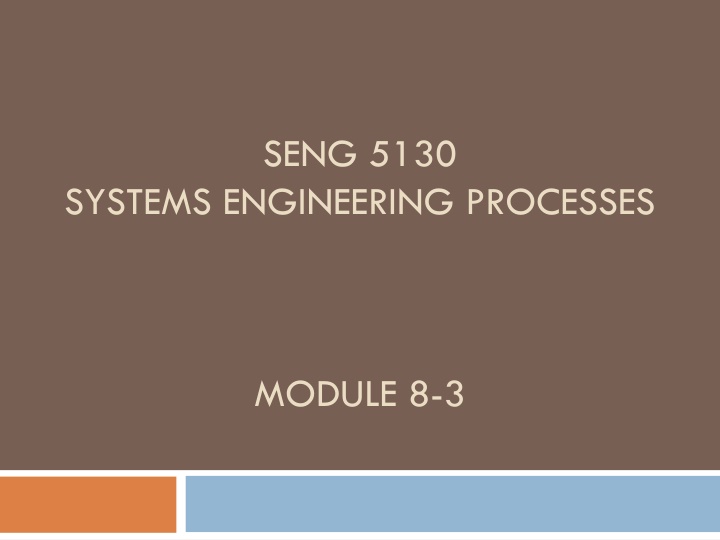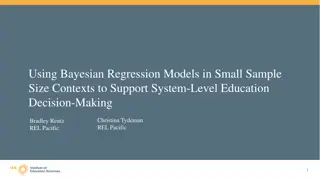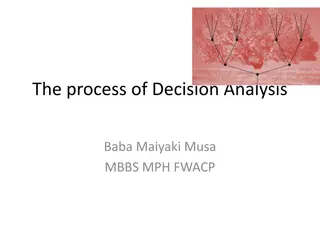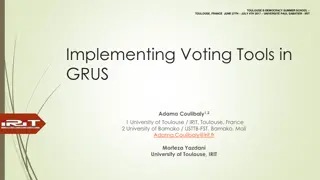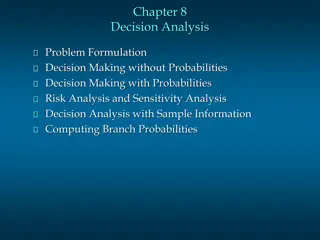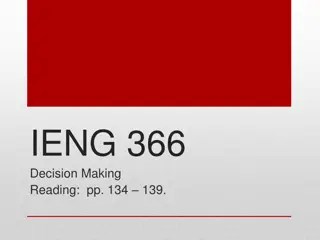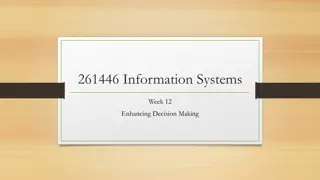Decision Analysis Tools and Models for Effective Decision-Making
The analysis of alternatives and decision-making processes in systems engineering is crucial for successful design and deployment. Various decision analysis tools, such as decision trees, decision matrix, cost/benefit analysis, force field analysis, grid analysis, and paired comparison analysis, help in evaluating and selecting the most suitable alternative. Understanding the steps of problem-solving and decision-making, along with structuring and analyzing the problem, leads to informed decisions and effective outcomes.
Download Presentation

Please find below an Image/Link to download the presentation.
The content on the website is provided AS IS for your information and personal use only. It may not be sold, licensed, or shared on other websites without obtaining consent from the author.If you encounter any issues during the download, it is possible that the publisher has removed the file from their server.
You are allowed to download the files provided on this website for personal or commercial use, subject to the condition that they are used lawfully. All files are the property of their respective owners.
The content on the website is provided AS IS for your information and personal use only. It may not be sold, licensed, or shared on other websites without obtaining consent from the author.
E N D
Presentation Transcript
SENG 5130 SYSTEMS ENGINEERING PROCESSES MODULE 8-3
MODULE 8 Alternatives and Models in Decision Making Decision Analysis Tools Decision Making under Uncertainty Decision Making under Risk 1. 2. 3.
Introduction The analysis of alternatives is a major requirement in systems design, development and deployment. Different decision analysis (making) tools exist to assist in picking the most suitable of these alternatives. Using wrong tool to analyze an alternative will produce wrong outcome. It is not an easy task deciding which of the proposed alternatives is the most suitable because - solutions to a complex system (problem) may come in different forms. - it may also be necessary to combine different alternatives, to achieve an outcome.
Steps of Problem Solving Decision-Making Define the Problem Identify the Alternatives Determine the Criteria Identify the Alternatives Choose an Alternative Structuring the Problem Analyzing the Problem Implement Selected Alternative Evaluate The Results Interpretation
Decision Analysis Tools Decision Trees Decision Matrix Cost/Benefit Analysis Force Field Analysis Grid Analysis Paired Comparison Analysis Intuition 1. 2. 3. 4. 5. 6. 7.
1. Decision Tree Present a structure from which alternatives can be viewed with possible outcomes of these alternatives. Present the analysis in graphic form. In a decision tree, a square represents a decision and a circle represents uncertainty, the lines coming out of the square represent the options/alternatives available at that stage, while the line coming from the circles represent the outcomes.
2. Decision Matrix This allows a bit / part of the decision analysis to be resolved at a time. The various alternatives and selection criteria are assigned suitable ratings and their output computed using mathematical models and equations .
Decision Evaluation Matrix Probability that the future will occur Alternative available for selectioin A future not under control of the decision maker Evaluation measure associated with the alternative and future.
3. Cost / Benefit Analysis Represent alternatives, uncertainties and outcomes in-term of monetary unit. Useful in predicting when to make a change in an alternative. Compute the cost of making a change. Compute the benefits of making the change. Compare the results from the above computations and interpret the result.
4. Force Field Analysis This is used in a similar way to cost / benefit analysis tool. The difference: monetary units are not used. The forces of merit and demerit are weighed using probability or percentages based on how significant the impacts of the forces are to the project. Reveal merits and demerits of a decision. Results from the analysis often suggest ways of reducing the demerits, and improving the merits of a decision. It presents ways of increasing the probability of success of a project.
5. Grid Analysis It is used to evaluate multi-criteria decision analysis processes. Setting up the alternatives in rows. Selection Criteria in column. Associating weight to criteria depending on their relative importance. Score each of the alternatives under each criterion. The overall importance is determined by summing the product of the score and the weight along each row.
6. Paired Comparison Analysis This tool is used to show the importance of an alternative relative to one another alternative. This tool is used where; - priorities are not clear, - resources are limited, and - alternatives are required to be compared on one one basis.
7. Intuition Controlled by the subconscious mind. Information is processed in parallel order, not sequential. Applicable in situation where; Time is limited and a rapid solution is required. The structure of the issue is poorly defined. There is no precedence. The issue is ambiguous, incomplete or with conflicting information. Alternatives and decision criteria are hard to articulate in unambiguous way.
Decision making and probabilities Using probabilities (aka Decision Making Under Risk ) probabilities can be assigned to the occurrence of states of nature in the future
Decision making and probabilities Not using probabilities (aka Decision Making Under Uncertainty) probabilities can NOT be assigned to the occurrence of states of nature in the future
IMPORTANT: Uncertainty = No Probability Risk = Probability
2. Decision Making Under Uncertainty
Payoff Table Conditions of Uncertainty States Of Nature a Payoff 1a Payoff 2a Decision 1 2 b Payoff 1b Payoff 2b Payoffs under each state of nature: Results of making a particular decision if the particular state of nature becomes true. Usually in terms of profit. Decision alternatives
Decision Making Under Uncertainty Maximax Criterion Extremely Optimistic: Choose decision with the 1. maximum of the maximum payoffs Maximin Criterion Extremely Pessimistic: Choose decision with the maximum of the minimum payoffs 2. Hurwicz Criterion 3. Choose decision in which decision payoffs are weighted by a coefficient of optimism, alpha Coefficient of optimism is a measure of a decision maker s optimism from 0 (completely pessimistic) to 1 (completely optimistic)\ In absence of probabilities, assume equal likelihood Laplace Criterion 4.
Class Exercise A factory is trying to decide whether to Expand a plant in South Carolina Whether to continue producing as it currently does Whether to sell the plant now Two state of nature could occur: Good foreign competitive conditions (little competition) Poor foreign competitive conditions (strong competition) Payoffs (results of our decision) will vary, depending on the state of nature
Class Exercise STATES OF NATURE DECISION Good Foreign Competitive Conditions Poor Foreign Competitive Conditions Expand Maintain status quo Sell now $ 800,000 1,300,000 320,000 $ 500,000 -150,000 320,000 Find the best alternative using: Maximax Maximin Hurwicz (if = 0.3) Laplace If p(good) = 0.7 1. 2. 3. 4. 5. 1-22
1. Maximax Solution Because we re optimistic STATES OF NATURE DECISION Good Foreign Competitive Conditions Poor Foreign Competitive Conditions Expand Maintain status quo Sell now $ 800,000 1,300,000 320,000 $ 500,000 -150,000 320,000 Expand: Status quo: Sell: Decision: ? $800,000 1,300,000 320,000 Choose decision with the maximum of the maximum payoffs
1. Maximax Solution (Contd) STATES OF NATURE DECISION Good Foreign Competitive Conditions Poor Foreign Competitive Conditions Expand Maintain status quo Sell now $ 800,000 1,300,000 320,000 $ 500,000 -150,000 320,000 Expand: Status quo: Sell: Decision: Maintain status quo $800,000 1,300,000 320,000 Maximum Choose decision with the maximum of the maximum payoffs
2. Maximin Solution Because we re pessimistic STATES OF NATURE DECISION Good Foreign Competitive Conditions Poor Foreign Competitive Conditions Expand Maintain status quo Sell now $ 800,000 1,300,000 320,000 $ 500,000 -150,000 320,000 Expand: $500,000 Status quo: -150,000 Sell: 320,000 Decision: ? Choose decision with the maximum of the minimum payoffs 1-25
2. Maximin Solution (contd) STATES OF NATURE DECISION Good Foreign Competitive Conditions Poor Foreign Competitive Conditions Expand Maintain status quo Sell now $ 800,000 1,300,000 320,000 $ 500,000 -150,000 320,000 Expand: $500,000 Status quo: -150,000 Sell: 320,000 Decision: Expand Maximum Choose decision with the maximum of the minimum payoffs 1-26
3. Hurwicz Criteria Maximax and maximin are too extreme Hurwicz: decision payoffs are weighted by a coefficient of optimism is a measure of a decision maker s optimism from 0 (completely pessimistic) to 1 (completely optimistic) For each decision alternative, the maximum payoff is multiplied by , and minimum payoff is multiplied by (1- ) 1-27
3. Hurwicz Criteria (contd) STATES OF NATURE DECISION Good Foreign Competitive Conditions Poor Foreign Competitive Conditions Expand Maintain status quo Sell now $ 800,000 1,300,000 320,000 $ 500,000 -150,000 320,000 Consider = 0.3 1 - = 0.7 Maximum Expand: $800,000(0.3) + 500,000(0.7) = $590,000 Status quo: 1,300,000(0.3) -150,000(0.7) = 285,000 Sell: 320,000(0.3) + 320,000(0.7) = 320,000 Decision: Expand 1-28
4. Laplace (Equal Likelihood Criteria) STATES OF NATURE DECISION Good Foreign Competitive Conditions Poor Foreign Competitive Conditions Expand Maintain status quo Sell now $ 800,000 1,300,000 320,000 $ 500,000 -150,000 320,000 Two states of nature each weighted 0.50 Expand: $800,000(0.5) + 500,000(0.5) = $650,000 Status quo: 1,300,000(0.5) -150,000(0.5) = 575,000 Sell: 320,000(0.5) + 320,000(0.5) = 320,000 Decision: Expand Maximum 1-29
3. Decision Making Under Risk (w. Probabilities)
Expected Value of a Decision Alternative Previously, we didn t have any information on the probabilities of the states of nature. The expected value of a decision alternative is the sum of weighted payoffs for the decision alternative. The expected value (EV) of decision alternative di is defined as: N = j = EV ( ) ( V ) d P s i j ij 1 where: N = the number of states of nature P(sj ) = the probability of state of nature sj Vij = the payoff corresponding to decision alternative di and state of nature sj
Decision Making with Probabilities: Example STATES OF NATURE DECISION Good Foreign Competitive Conditions Poor Foreign Competitive Conditions Expand Maintain status quo Sell now $ 800,000 1,300,000 320,000 $ 500,000 -150,000 320,000 Consider p (good) = 0.70 p (poor) = 0.30 EV(expand): $800,000(0.7) + 500,000(0.3) = $710,000 EV(status quo): 1,300,000(0.7) -150,000(0.3) = 865,000 Maximum EV(sell): 320,000(0.7) + 320,000(0.3) = 320,000 Decision: Status quo 1-32
Class Exercise: Burger Prince Burger Prince Restaurant is considering opening a new restaurant on Main Street. It has three different models, each with a different seating capacity. Burger Prince estimates that the average number of customers per hour will be 80, 100, or 120 with probabilities of 0.4, 0.2, and 0.4 respectively. The payoff table for the three models is on the next slide.
Payoff Table Average Number of Customers Per Hour s1 = 80 s2 = 100 s3 = 120 p = 0.4 p = 0.2 p = 0.4 Model A $10,000 $15,000 $14,000 Model B $ 8,000 $18,000 $12,000 Model C $ 6,000 $16,000 $21,000
CLASS EXERCISE: Expected Value Approach 1. Draw a Decision Tree showing each of the possible decisions. 2. Calculate the expected value for each decision. 3. Which model should be chosen, and why? Please use the submission link provided within Module 8 on Blackboard to submit the assignment.
References The following references are used to compile the slides for this module: Forrester, (1971) World Dynamics. Pegasus Communications, Waltham, Massachusetts. Blanchard and Fabrycky (2010). Systems Engineering and Analysis (5th Edition). Published by Prentice Hall. Faulconbridge and Ryan (2003). Managing Complex Technical Projects: A Systems Engineering Approach. Published by Artech House, Inc. Blanchard (2008). Systems Engineering Management. 4th Ed., Published by Wiley Series Kossiakoff, Sweet, Seymour and Biemer (2011). Systems Engineering Principles and Practice. Wiley. INCOSE Systems Engineering Handbook, v.3.2 Buede (2009). The Engineering Design of Systems: Models and Methods. Wiley. Sage and Armstrong (2000). Introduction to Systems Engineering. Wiley.
